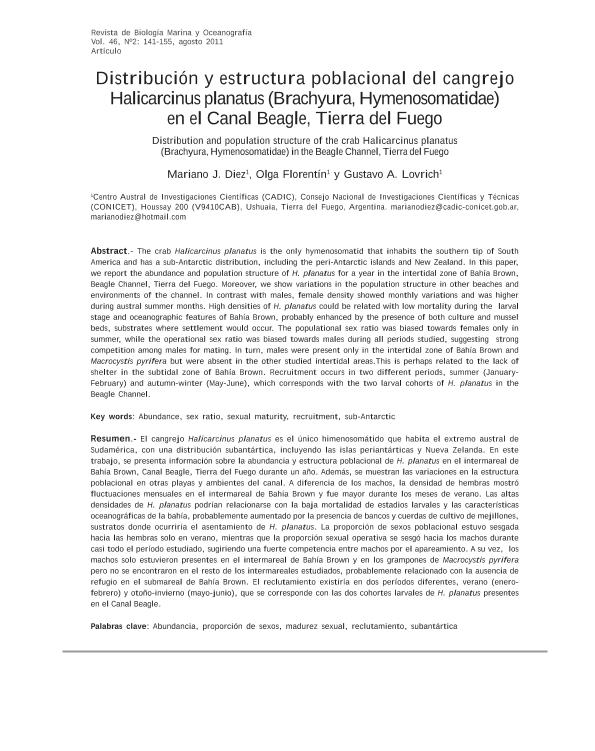Mostrar el registro sencillo del ítem
dc.contributor.author
Diez, Mariano Javier

dc.contributor.author
Florentin, Olga Viviana

dc.contributor.author
Lovrich, Gustavo Alejandro

dc.date.available
2017-02-08T21:03:16Z
dc.date.issued
2011-08
dc.identifier.citation
Diez, Mariano Javier; Florentin, Olga Viviana; Lovrich, Gustavo Alejandro; Distribución y estructura poblacional del cangrejo Halicarcinus planatus (Brachyura, Hymenosomatidae) en el Canal Beagle, Tierra del Fuego; Universidad de Valparaíso. Facultad de Ciencias del Mar; Revista de Biología Marina y Oceanografía; 46; 2; 8-2011; 141-155
dc.identifier.issn
0717-3326
dc.identifier.uri
http://hdl.handle.net/11336/12745
dc.description.abstract
El cangrejo Halicarcinus planatus es el único himenosomátido que habita el extremo austral de Sudamérica, con una distribución subantártica, incluyendo las islas periantárticas y Nueva Zelanda. En este trabajo, se presenta información sobre la abundancia y estructura poblacional de H. planatus en el intermareal de Bahía Brown, Canal Beagle, Tierra del Fuego durante un año. Además, se muestran las variaciones en la estructura poblacional en otras playas y ambientes del canal. A diferencia de los machos, la densidad de hembras mostró fluctuaciones mensuales en el intermareal de Bahía Brown y fue mayor durante los meses de verano. Las altas densidades de H. planatus podrían relacionarse con la baja mortalidad de estadios larvales y las características oceanográficas de la bahía, probablemente aumentado por la presencia de bancos y cuerdas de cultivo de mejillones, sustratos donde ocurriría el asentamiento de H. planatus. La proporción de sexos poblacional estuvo sesgada hacia las hembras solo en verano, mientras que la proporción sexual operativa se sesgó hacia los machos durante casi todo el período estudiado, sugiriendo una fuerte competencia entre machos por el apareamiento. A su vez, los machos solo estuvieron presentes en el intermareal de Bahía Brown y en los grampones de Macrocystis pyrifera pero no se encontraron en el resto de los intermareales estudiados, probablemente relacionado con la ausencia de refugio en el submareal de Bahía Brown. El reclutamiento existiría en dos períodos diferentes, verano (enero-febrero) y otoño-invierno (mayo-junio), que se corresponde con las dos cohortes larvales de H. planatus presentes en el Canal Beagle.
dc.description.abstract
The crab Halicarcinus planatus is the only hymenosomatid that inhabits the southern tip of South America and has a sub-Antarctic distribution, including the peri-Antarctic islands and New Zealand. In this paper, we report the abundance and population structure of H. planatus for a year in the intertidal zone of Bahía Brown, Beagle Channel, Tierra del Fuego. Moreover, we show variations in the population structure in other beaches and environments of the channel. In contrast with males, female density showed monthly variations and was higher during austral summer months. High densities of H. planatus could be related with low mortality during the larval stage and oceanographic features of Bahía Brown, probably enhanced by the presence of both culture and mussel beds, substrates where settlement would occur. The populational sex ratio was biased towards females only in summer, while the operational sex ratio was biased towards males during all periods studied, suggesting strong competition among males for mating. In turn, males were present only in the intertidal zone of Bahía Brown and Macrocystis pyrifera but were absent in the other studied intertidal areas.This is perhaps related to the lack of shelter in the subtidal zone of Bahía Brown. Recruitment occurs in two different periods, summer (January-February) and autumn-winter (May-June), which corresponds with the two larval cohorts of H. planatus in the Beagle Channel.
dc.format
application/pdf
dc.language.iso
spa
dc.publisher
Universidad de Valparaíso. Facultad de Ciencias del Mar
dc.rights
info:eu-repo/semantics/openAccess
dc.rights.uri
https://creativecommons.org/licenses/by-nc-sa/2.5/ar/
dc.subject
Abundancia
dc.subject
Proporción de Sexos
dc.subject
Madurez Sexual
dc.subject
Reclutamiento
dc.subject
Subantártica
dc.subject.classification
Otras Ciencias Biológicas

dc.subject.classification
Ciencias Biológicas

dc.subject.classification
CIENCIAS NATURALES Y EXACTAS

dc.title
Distribución y estructura poblacional del cangrejo Halicarcinus planatus (Brachyura, Hymenosomatidae) en el Canal Beagle, Tierra del Fuego
dc.title
Distribution and population structure of the crab Halicarcinus planatus (Brachyura, Hymenosomatidae) in the Beagle Channel, Tierra del Fuego
dc.type
info:eu-repo/semantics/article
dc.type
info:ar-repo/semantics/artículo
dc.type
info:eu-repo/semantics/publishedVersion
dc.date.updated
2017-02-07T18:01:43Z
dc.identifier.eissn
0718-1957
dc.journal.volume
46
dc.journal.number
2
dc.journal.pagination
141-155
dc.journal.pais
Chile

dc.journal.ciudad
Valparaíso
dc.description.fil
Fil: Diez, Mariano Javier. Consejo Nacional de Investigaciones Científicas y Técnicas. Centro Austral de Investigaciones Científicas; Argentina
dc.description.fil
Fil: Florentin, Olga Viviana. Consejo Nacional de Investigaciones Científicas y Técnicas. Centro Austral de Investigaciones Científicas; Argentina
dc.description.fil
Fil: Lovrich, Gustavo Alejandro. Consejo Nacional de Investigaciones Científicas y Técnicas. Centro Austral de Investigaciones Científicas; Argentina
dc.journal.title
Revista de Biología Marina y Oceanografía

dc.relation.alternativeid
info:eu-repo/semantics/altIdentifier/url/http://www.revbiolmar.cl/index.php?option=com_content&view=article&id=599%3A141-155-&catid=951&Itemid=68&lang=es
dc.relation.alternativeid
info:eu-repo/semantics/altIdentifier/url/http://ref.scielo.org/dhhnh9
dc.relation.alternativeid
info:eu-repo/semantics/altIdentifier/doi/http://dx.doi.org/10.4067/S0718-19572011000200005
dc.relation.alternativeid
info:eu-repo/semantics/altIdentifier/url/http://www.redalyc.org/articulo.oa?id=47919988005
dc.relation.alternativeid
info:eu-repo/semantics/altIdentifier/url/https://dialnet.unirioja.es/servlet/articulo;jsessionid=56AC13F3D074F16890AF3F76E46B4EF1.dialnet01?codigo=5253918
Archivos asociados
